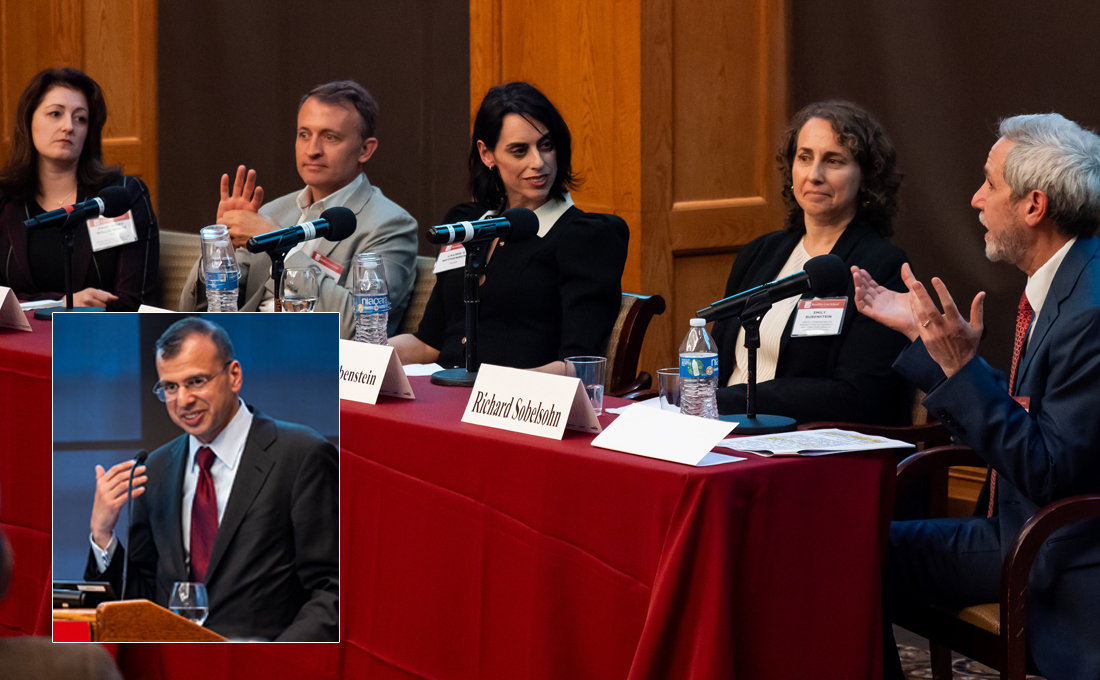Sustainability Thought Leaders Address Accomplishments and Challenges of a Resilient Built Environment at Boot Camp

Creating a built environment that can sustain the many impacts of climate change—rising seas, droughts, wildfires, and extreme weather events—entails great innovation and forward thinking in policy, design, and construction, and meticulous planning to implement these innovations. Examining the current landscape and goals for the future, including their cost, was the topic of Brooklyn Law School’s third annual Sustainability and Future Cities Boot Camp, titled “Resiliency, the Built Environment, and How to Pay for What is Needed.”
Organized and moderated by Professor of Practice and Adjunct Professor of Law Richard J. Sobelsohn ’98, the April 11 event featured keynote speaker Rohit T. Aggarwala, commissioner of the New York City Department of Environmental Protection and the city’s chief climate officer.
Brooklyn Law School President and Joseph Crea Dean David D. Meyer welcomed the Boot Camp participants, speaking of the importance of the discussion that followed, especially amid recent natural disasters. He cited the earthquake in Taiwan, where planning for more resilient infrastructure made an incredible difference, resulting in a less severe toll on human life and property.
In his keynote, Aggarwala, who, as chief climate officer, led the development of New York City’s most recent sustainability plan, PlaNYC, both celebrated the city’s progress and described the challenges ahead.
“New York was very much a leader, among a handful of cities that took sustainability seriously in a systematic way,” he said, citing the city’s “aggressive mandatory efforts to rein in carbonization in existing buildings,” resulting in compliance with the federal Clean Air Act.
As another hurricane season approaches, Aggarwala said, the city is much more prepared than it was in late October 2012, when Superstorm Sandy struck. A substantial portion of the $12 billion in federal funding that the city received in the storm’s aftermath has gone toward ensuring that buildings and critical facilities are protected or are resilient. Yet, he added, that money was allocated to areas of the city that were damaged by Sandy, and there are many more vulnerable neighborhoods in the five boroughs that require both local and federal investment to become resilient. That, he said, requires comprehensive planning, which is currently underway and evolving.
“We are reactive, not planners,” Aggarwala said. “But we have to think about coastal resilience and climate change adaptation broadly, not as a project, not as something that will happen in development. It's an ongoing task, and the work of decades.”
That work toward resiliency, he said, which will include extensive modifications to the stormwater infrastructure, projects such as the completion of a sea wall on the Lower East Side, and the retrofitting of existing buildings under Local Law 97, will entail “a breathtaking sum of money, and there is no cap.”
There is a great need to find the tools for the city’s low- and moderate-value residential buildings to obtain financing for the projects necessary to reach compliance with Local Law 97, Aggarwala said. That may come from the federal government, the state, the Public Service Commission, and through city property tax credits—all of which he and his department are at work on attaining.
In the end, Aggarwala said, “Climate action in New York City is no longer about policy. We’ve done the policy work, between the city, the state, and the federal government’s bipartisan infrastructure law. Climate action in New York City is about the nuts and bolts of implementation. It is a great challenge, but an exciting one. And I’m excited that Brooklyn Law School is interested in being a part of it.”
A panel discussion on resiliency and sustainability efforts and their costs followed, led by Professor Sobelsohn and with expert participants Emily Rubenstein, deputy commissioner of resiliency and sustainability for the New York State Office of General Services; Laurie Rothenberg, lead counsel for global real estate and workplace strategy at Pfizer; Mark Jackson ’11, general counsel and vice president for Industry City; and Mary Willis White ’13, partner at Raines Feldman Littrell and adjunct professor at Brooklyn Law School.
Rubenstein discussed New York State’s Clean Water, Clean Air, and Green Jobs Environmental Bond Act, passed in 2022, which targets a 40 percent reduction in greenhouse gas emissions by 2040, and includes a $4.2 billion investment.
“It is one of the most ambitious laws in the nation, and well on its path” she said. Three key pieces of have been investing in renewable energy; a new cap-and-trade program which will have decreasing limits on emissions; and, she said, “a radical and significant shift in New York City’s building code” for new construction away from the use of fossil fuels and toward electricity. Investment in new technology, she added, is playing a large part in enabling the transition to clean energy and resilience.
Jackson discussed energy-efficient measures Industry City has implemented, such as switching from gas to steam heat using heat pump systems, its development of green spaces on its campus, and utilizing permeable surfaces that are more resilient to flooding. That is attractive to commercial tenants, who seek to meet their ESG (environmental, social, and governance) goals, he said.
Willis White spoke of the challenges her clients face to comply with the standards set by Local Law 97, and of her firm’s efforts to be proactive on their behalf to help them to secure necessary funding. Private investment is a critical part of financing these projects, she said.
At Pfizer, said Rothenberg, “site selection for its buildings is key to targeting resilience.” She and her team use a designated “health and safety checklist” for site selection, layering specific environmental and sustainability considerations into every project they undertake. It’s necessary, she said, to look not just at the internal issues of compliance but to look outward, evaluating how it will affect the community and the ecosystem.
The Boot Camp was sponsored by the Brooklyn Real Estate Society. Photos of the event are on Flickr, or view the video of the full event.